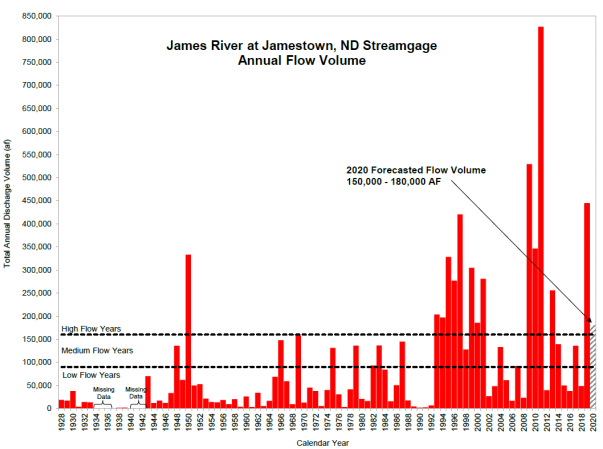
JAMESTOWN, N.D. (NewsDakota.com) – All of the flood storage, at Jamestown and Pipestem reservoirs, is currently available for the spring runoff. Pipestem Reservoir is currently at pool elevation, 1441.8 feet, with a release of 100 cubic feet per second. Jamestown Reservoir is currently at pool elevation, 1426.0 feet, with a release of 450 cubic feet per second.
Winter releases continued steadily since December with a significant volume of water being released over the winter months. From Dec. 1, 2019 to March 1, the volume of water released from Jamestown Dam would have filled the reservoir to its normal pool levels more than three times. At Pipestem Dam, the reservoir would have been filled to its normal pool level more than four times. Releases since Oct. 1, would have filled Jamestown eight times and Pipestem 18 times.
For the 2020 runoff year, initial flow volume forecasts indicate a medium to high flow year is expected at the James River at Jamestown, North Dakota, streamgage. The figure below shows historical annual flow volume including the 2020 forecast at that location.
In high flow years, the primary objective of flood control operations is to evacuate both flood pools as quickly as possible at a rate that will minimize the risk of uncontrolled spillway flow, in an effort to minimize downstream damage. The Corps of Engineers will attempt to follow normal evacuation targets of June 1, at Jamestown Dam, and September 1, at Pipestem Dam, but the exact schedule of release rates will depend on how the event occurs.
The current forecast indicates that maximum combined releases between 750 cubic feet per second, and 1,200 cubic feet per second, are expected; however, additional snow accumulation or significant spring or summer rainfall could necessitate higher release levels. An interagency meeting will be held in Jamestown in late March, and a release schedule will be developed after that meeting.
The National Operation Hydrologic Remote Sensing Center’s snow accumulation model currently shows an average of two inches of snow water equivalent in the upper James River and Pipestem Creek basins. Soils are still frozen in the upper basin with varying depths depending on the snow cover in the area. Soil moisture conditions in the entire James River valley are extremely saturated.
